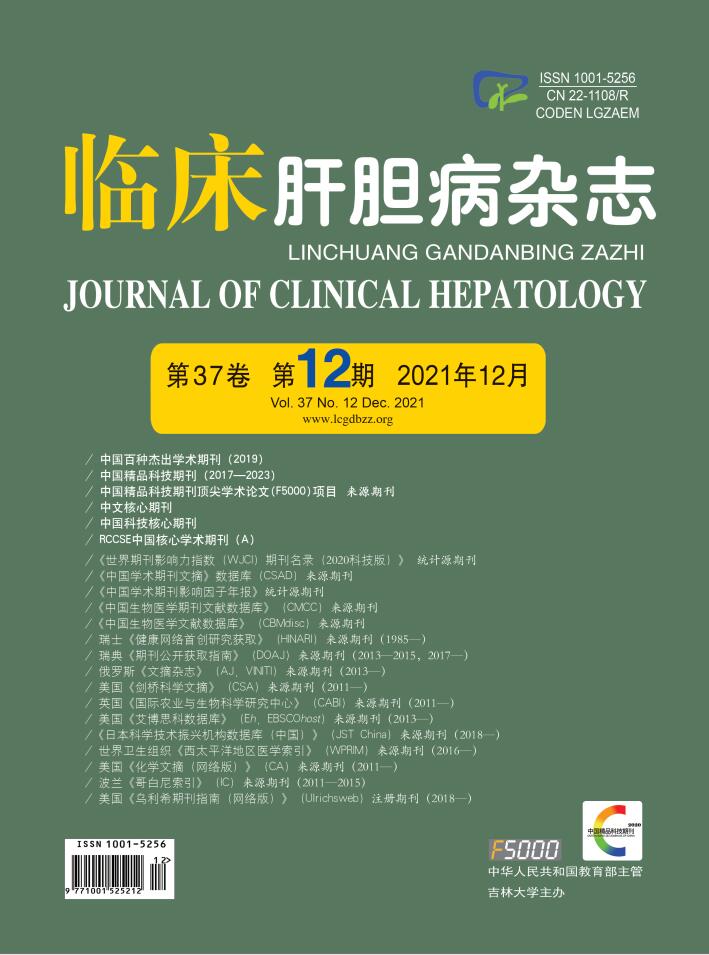| [1] |
LIN SC, FENG G, LIU JL, et al. From nonalcoholic fatty liver disease to metabolic fatty liver disease: An analysis based on disease heterogeneity[J]. J Clin Hepatol, 2020, 36(11): 2597-2600. DOI: 10.3969/j.issn.1001-5256.2020.11.045. |
| [2] |
ESLAM M, NEWSOME PN, SARIN SK, et al. A new definition for metabolic dysfunction-associated fatty liver disease: An international expert consensus statement[J]. J Hepatol, 2020, 73(1): 202-209. DOI: 10.1016/j.jhep.2020.03.039. |
| [3] |
JARVIS H, CRAIG D, BARKER R, et al. Metabolic risk factors and incident advanced liver disease in non-alcoholic fatty liver disease (NAFLD): A systematic review and meta-analysis of population-based observational studies[J]. PLoS Med, 2020, 17(4): e1003100. DOI: 10.1371/journal.pmed.1003100. |
| [4] |
MIR HM, STEPANOVA M, AFENDY H, et al. Association of sleep disorders with nonalcoholic fatty liver disease (NAFLD): A population-based study[J]. J Clin Exp Hepatol, 2013, 3(3): 181-185. DOI: 10.1016/j.jceh.2013.06.004. |
| [5] |
KIM JH, JUNG DH, KWON YJ, et al. The impact of the sleep duration on NAFLD score in Korean middle-aged adults: A community-based cohort study[J]. Sleep Med, 2019, 57: 144-150. DOI: 10.1016/j.sleep.2019.02.012. |
| [6] |
TARGHER G. Concordance between MAFLD and NAFLD diagnostic criteria in 'real-world' data[J]. Liver Int, 2020, 40(11): 2879-2880. DOI: 10.1111/liv.14623. |
| [7] |
XUE R, FAN JG. Brief introduction of an international expert consensus statement: A new definition of metabolic associated fatty liver disease[J]. J Clin Hepatol, 2020, 36(6): 1224-1227. DOI: 10.3969/j.issn.1001-5256.2020.06.007. |
| [8] |
LAUDISIO A, GIOVANNINI S, FINAMORE P, et al. Metabolic syndrome is associated with better quality of sleep in the oldest old: Results from the "Mugello Study"[J]. Diabetol Metab Syndr, 2020, 12: 46. DOI: 10.1186/s13098-020-00554-y. |
| [9] |
JANSSEN KC, PHILLIPSON S, O'CONNOR J, et al. Validation of the epworth sleepiness scale for children and adolescents using rasch analysis[J]. Sleep Med, 2017, 33: 30-35. DOI: 10.1016/j.sleep.2017.01.014. |
| [10] |
KANAGARAJAN K, GOU K, ANTINORA C, et al. Morningness-eveningness questionnaire in bipolar disorder[J]. Psychiatry Res, 2018, 262: 102-107. DOI: 10.1016/j.psychres.2018.02.004. |
| [11] |
ZENOVIA S, STANCIU C, SFARTI C, et al. Vibration-controlled transient elastography and controlled attenuation parameter for the diagnosis of liver steatosis and fibrosis in patients with nonalcoholic fatty liver disease[J]. Diagnostics (Basel), 2021, 11(5): 787. DOI: 10.3390/diagnostics11050787. |
| [12] |
Chinese Foundation for Hepatitis Prevention and Control, Chinese Society of Infectious Disease, Chinese Society of Hepatology, et al. Consensus on clinical application of transient elastography detecting liver fibrosis: A 2018 update[J]. Chin Hepatol, 2019, 27(3): 182-191. DOI: 10.3760/cma.j.issn.1007-3418.2019.03.004. |
| [13] |
ESTES C, ANSTEE QM, ARIAS-LOSTE MT, et al. Modeling NAFLD disease burden in China, France, Germany, Italy, Japan, Spain, United Kingdom, and United States for the period 2016-2030[J]. J Hepatol, 2018, 69(4): 896-904. DOI: 10.1016/j.jhep.2018.05.036. |
| [14] |
BAYOUMI A, GRØNBÆK H, GEORGE J, et al. The epigenetic drug discovery landscape for metabolic-associated fatty liver disease[J]. Trends Genet, 2020, 36(6): 429-441. DOI: 10.1016/j.tig.2020.03.003. |
| [15] |
RYU S, CHANG Y, KIM SG, et al. Serum uric acid levels predict incident nonalcoholic fatty liver disease in healthy Korean men[J]. Metabolism, 2011, 60(6): 860-866. DOI: 10.1016/j.metabol.2010.08.005. |
| [16] |
GAULD C, LOPEZ R, GEOFFROY PA, et al. A systematic analysis of ICSD-3 diagnostic criteria and proposal for further structured iteration[J]. Sleep Med Rev, 2021, 58: 101439. DOI: 10.1016/j.smrv.2021.101439. |
| [17] |
WONG WS, FIELDING R. Prevalence of insomnia among Chinese adults in Hong Kong: A population-based study[J]. J Sleep Res, 2011, 20(1 Pt 1): 117-126. DOI: 10.1111/j.1365-2869.2010.00822.x. |
| [18] |
WIJARNPREECHA K, THONGPRAYOON C, PANJAWATANAN P, et al. Insomnia and risk of nonalcoholic fatty liver disease: A systematic review and meta-analysis[J]. J Postgrad Med, 2017, 63(4): 226-231. DOI: 10.4103/jpgm.JPGM_140_17. |
| [19] |
LI H, GUO M, AN Z, et al. Prevalence and risk factors of metabolic associated fatty liver disease in Xinxiang, China[J]. Int J Environ Res Public Health, 2020, 17(6): 1818 -1830. DOI: 10.3390/ijerph17061818. |
| [20] |
TROVATO FM, MARTINES GF, BRISCHETTO D, et al. Fatty liver disease and lifestyle in youngsters: Diet, food intake frequency, exercise, sleep shortage and fashion[J]. Liver Int, 2016, 36(3): 427-433. DOI: 10.1111/liv.12957. |
| [21] |
DULAI PS, SINGH S, PATEL J, et al. Increased risk of mortality by fibrosis stage in nonalcoholic fatty liver disease: Systematic review and meta-analysis[J]. Hepatology, 2017, 65(5): 1557-1565. DOI: 10.1002/hep.29085. |
| [22] |
WONG GL. Update of liver fibrosis and steatosis with transient elastography (Fibroscan)[J]. Gastroenterol Rep (Oxf), 2013, 1(1): 19-26. DOI: 10.1093/gastro/got007. |







 DownLoad:
DownLoad: